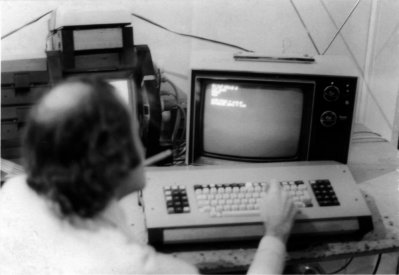‘The Automation of Electronic Wallpaper’
Article by Ariel, published in Access VIDEO, Vol. 5, no. 1, p. 23, 1979
The new generation of low cost video hardware has greatly increased the automated dissemination of information. The presentation of information becomes more plastic, more amenable to manipulation and ultimately more effective. But ...
Is it any easier to represent abstract concepts or experiences? What if the idea you wish to express cannot be shot with a camera? Pehaps you require image synthesis!
As low cost video equipment made available more sophisticated communication tools to a greater range of people, so too microcomputers have increased the scope of existing techniques as well as making possible new and untried methods of image and sound production.
Certain types of microcomputers now support very exotic forms of input/output other than the classical typewriter-style printing terminal or its electronic equivalent (VDU). Some examples are: voice input, speech output, music synthesizers, and ‘medium resolution graphic display interfaces’.
The latest generation of computer display interfaces are Rasta-scan devices; that is, they produce video which are displayed on monitors.
The board that was used to generate the computer images on the cover of this issue is a Matrox Alt 256-Graphics Board. The on-board sync generater produces reasonable interlaced industrial sync and therefore can be recorded diectly on a VTR.
The board has a 256 vertical x 256 horizontal screen memory (each pixel is either on or off) which gives you 65,536 dots to push round under program control. You can also have up to eight boards in a standard microcomputer system, which doesn't increase your horizontal or vertical resolution but increases the Z-resolution (256 different colours or grey levels at any of the 65,536 points).
At the moment I am using the system for the generation of mandala-like patters (akin to harmonographs) which are being recorded as photographs using an 8 x 10 colour photographic system.
Ultimately I am interested in producing completely electronically synthesised video tapes where the computer generates the images (animation), music soundtrack, voice overs and textual information. I already have the minimal hardware configuration for the above-mentioned, the missing link at the moment being the requisite software (programs and data) to implement it. (Which is just a matter of time.)
“You are only limited by your imagination and your access to infomation!”
ARIEL





